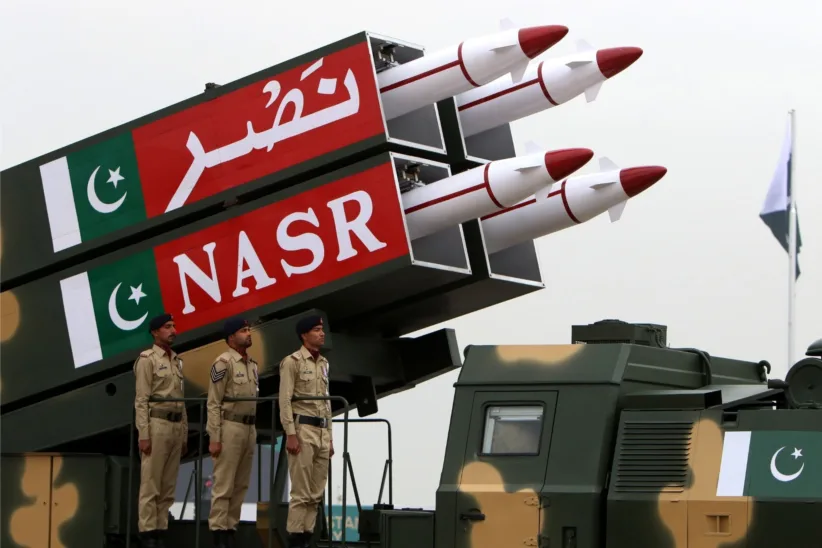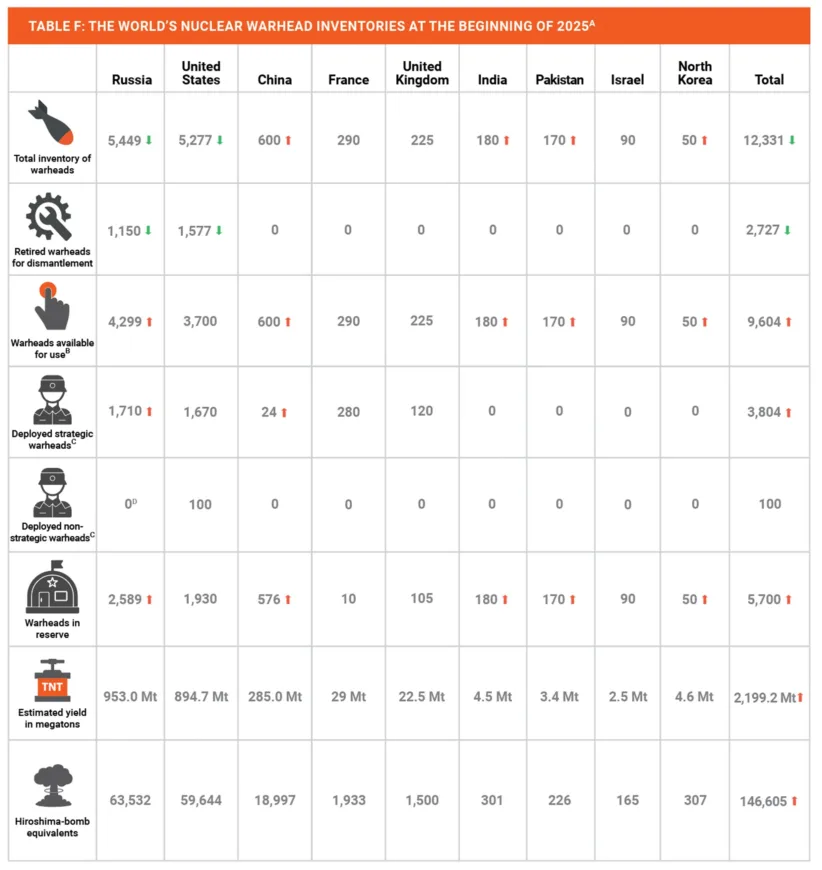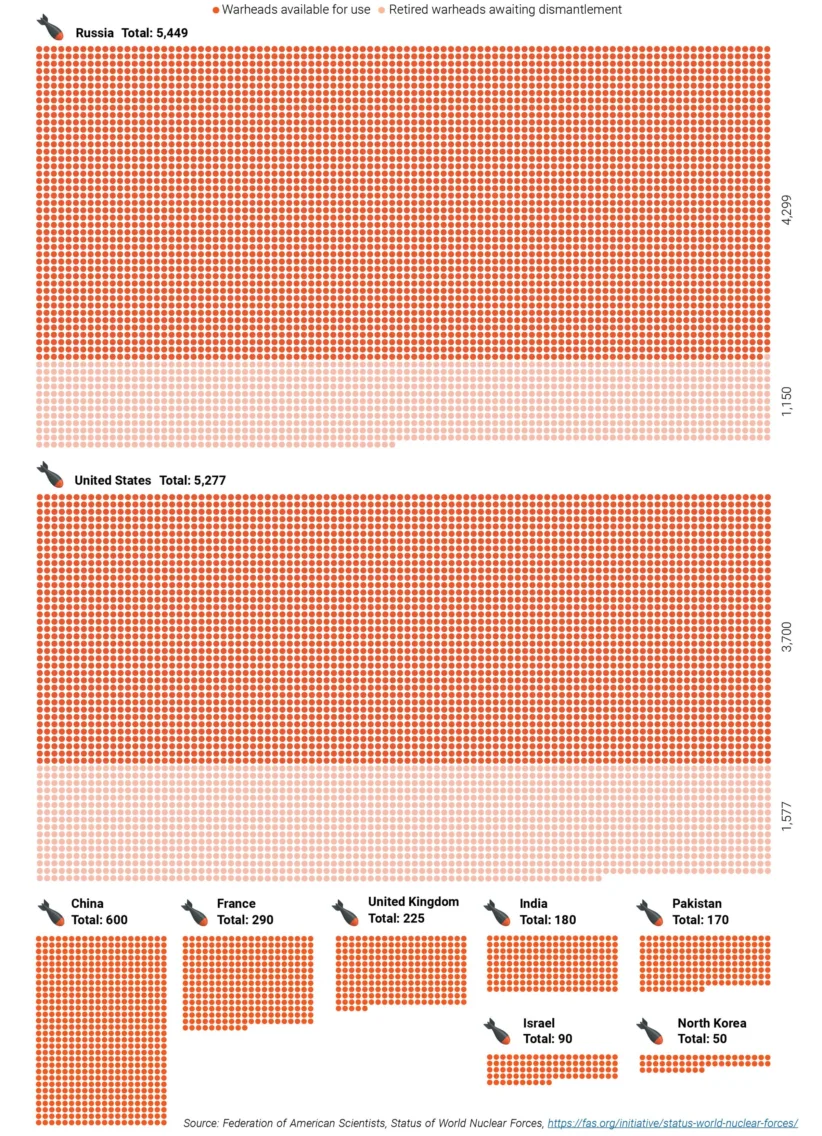The prohibition on possession and stockpiling
The Nuclear Weapons Ban Monitor collaborates with the Nuclear Information Project of the Federation of American Scientists to estimate and analyse global nuclear forces. At the beginning of 2025, the nine nuclear armed states had a combined inventory of approximately 12,331 nuclear warheads, which is, of course, incompatible with the TPNW’s prohibition on possession and stockpiling of nuclear weapons.

The world’s nuclear warhead inventories at the beginning of 2025 are summarised in the table and figure below. It is estimated that 9,604 of the world’s total inventory of warheads are available for use by the military, with an estimated collective yield equivalent to more than 146,500 Hiroshima bombs. The remaining 2,727 warheads had previously been retired and are awaiting dismantlement in Russia and the United States.
The total inventory of warheads decreased by approximately 16 from 12,347 warheads in early 2024 to 12,331 in early 2025. This reduction was only, however, due to Russia and the United States dismantling a small number of previously retired nuclear weapons during the course of 2024. Indeed, that the total number of nuclear weapons in the world is slowly decreasing each year is entirely the result of dismantlement of retired warheads by these two states.
Scratching below the surface of the data produces a much bleaker picture: the global number of stockpiled nuclear weapons available for use has been steadily increasing since 2017, when it reached an all-time low of 9,272 warheads. China, India, North Korea, Pakistan, and Russia all continued to expand their nuclear arsenals in 2024, and China most dramatically by roughly 100 warheads per year and mainly for the hundreds of new ICBL siloes that it is constructing.
As mentioned above, the total number of nuclear warheads available for use had increased to 9,604 at the beginning of 2025. Meanwhile, the number of warheads dismantled each year appears to be decreasing, and the dismantlement rate is no longer keeping pace with the number of new warheads that are entering global nuclear stockpiles. This means we could soon reach a point where also the total number of nuclear weapons in the world will actually increase for the first time since 1986.
Combined, the United States and Russia now possess approximately 87% of the world’s total inventory of nuclear weapons and 83% of the stockpiled warheads available for use by the military. These percentages have been shrinking over the past few years and are likely to continue to do so as other states increase their nuclear arsenals.
Estimates of nuclear warhead inventories can fluctuate from year to year depending on a variety of factors like routine maintenance, the changing pace of warhead retirement, and modernisation schedules. As a result, it is more appropriate to consider the general trends of each country’s inventory over several years. As noted, China, India, North Korea, Pakistan, and Russia are all generally increasing the size of their nuclear stockpiles. In contrast, the stockpiles of France, Israel, and the United States are generally stable. The UK government in 2021 announced a significant increase to the upper limit of its warhead inventory compared with previous plans, but there is no publicly available evidence to indicate that such an increase has begun.
For more information, see the 2024 edition of the Nuclear Weapons Ban Monitor.
The world's nuclear warhead inventories at the beginning of 2025

The world's nuclear warhead inventories at the beginning of 2025

Article 1(1)(a) - INTERPRETATION
Each State Party undertakes never under any circumstances to: [...] possess or stockpile nuclear weapons or other nuclear explosive devices.
- The prohibition on possession of any nuclear weapon or other nuclear explosive device under Article 1(1)(a) makes it illegal to have a nuclear weapon or other nuclear explosive device.
- Possession does not require ownership.
- One nuclear weapon or other form of nuclear explosive device is sufficient to constitute a stockpile.
- The prohibition on possession covers activities such as maintenance and deployment of nuclear weapons or other nuclear explosive devices. Indirectly, it also acts to render nuclear deterrence practices unlawful.